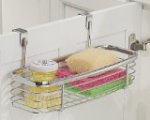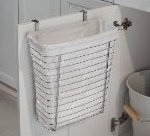- When Buying New Kitchen Cabinets
Most homeowners, when buying new kitchen cabinets get so involved in the purchase that they forget that this is a long-term investment in their home. Once you have chosen your kitchen cabinets their are some things you need to know and some additional items that you should purchase.
- Of primary concern, you should always know the name and address of the actual manufacturer of the kitchen cabinets. This is exceptionally important if you are purchasing from a big-box retailer as in many cases the kitchen cabinets will arrive with their name or trade name on them.
- If the cabinets are stained or painted wood, request the formulation of the stain or paint. Although we recommend that you purchase a container of stain or paint (see next paragraph), stain or paint in a container will not last as long as the cabinets and it is possible that when you need to use it, it will have dried out.
- Ask for the manufacturer's cleaning recommendations.
- Request the gloss factor of the finish and what it is - name and manufacturer. There are many finishes available and it is important to know the exact finish used should a repair be necessary. A semi-gloss polyurethane from one manufacture can be substantially different than a semi-gloss polyurethane from a different manufacture.
- You are making a large investment and should spend a few extra dollars on some replacement parts. In the overall price of the kitchen cabinets, it is a minor amount of money.
- Extra hinges - at minimum one set of each type of hinge used on the kitchen cabinets.
- Drawer slides - at minimum one spare set of each type of drawer slide used in the kitchen cabinets.
- Drawer knobs - 2 of each type of drawer pull used, including back plates if used.
- Door pulls - 2 of each type of door pull used, including back plates if used.
- Repair kit - many manufacturers offer a repair kit for their cabinetry.
- A pint of each of the stains or paints used to finish the cabinets.
Why is it important to know the name of the actual manufacture of the kitchen cabinets? If in a few years, you require a replacement piece, and the big-box retailer no longer uses the same manufacture, you won't be able to get identical replacement pieces.

Figure 4 - Light weight cabinet door organizer

Figure 5 - Garbage cans mounted to kitchen cabinet doors can cause hinges to bend.
When the kitchen cabinets and the parts arrive, place them in a plastic bag, that has some air ventilation in it, and put the bag on the top shelf in one of the cabinets. You won't need the spare parts for quite some time and if they are left in the kitchen cabinets you will be able to find them when you need them.
Don't use the spare kitchen cabinet parts for other projects!
- After Kitchen Cabinet Installation Do's and Don'ts
Once the cabinets are installed you should care for them as expensive pieces of furniture.
- Wet or damp towels that hang over doors and drawer fronts will damage the finish.
- Cabinet door organizers can be a great addition to your new kitchen cabinets. However, be aware of the additional weight you are adding to the hinges. Light weight organizers (Figure 4) will generally not do any damage, however, organizers that hold gallons of liquids or garbage (Figure 5) will damage hinges. In the same manner do not allow children to use the kitchen cabinet doors as a new swing set or to use the kitchen cabinet drawers as a ladder to get to the cookie jar.
- React quickly to spills. Although most kitchen cabinet finishes are designed to be stain resistant, the longer a spill is left on the kitchen cabinet material the more likely damage will occur. Use a cleaner recommended by the manufacturer. In most cases it is not wise to use any abrasive, ammonia or chlorine based cleaner on kitchen cabinetry.
- React quickly to grease splatter and/or finger and hand print grime. Cabinets that are in proximity of range tops, are subject to grease splatter when cooking, no matter how careful the chef is! If grease ended up on the dining room table it would be cleaned-up instantly. Your kitchen cabinets deserve the same care!
Bent hinges and drawer slides are almost impossible to put back to their original shape and generally need to be replaced.
It is best to mount organizers that will carry any substantial weight inside cabinets rather than on doors.
